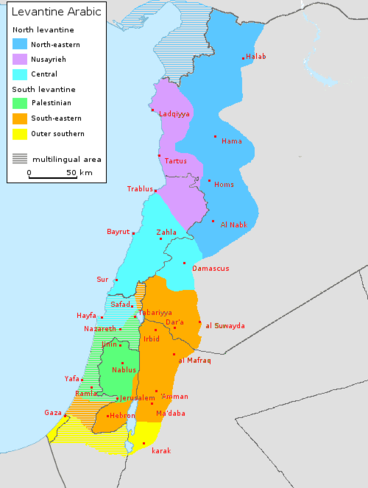Levantine Arabic (Shami شامي ) is the variety of Arabic spoken by people in the region along the Eastern part of the Mediterranean Sea. This region is called the Levant and it includes the countries Syria, Jordan, Lebanon, Palestine, and some southern parts of Turkey. There are more than 32 million people speaking Levantine Arabic.
Levantine Arabic was heavily influenced by preexisting languages such as Syriac and Aramaic languages. Today, you will find many English and French words influencing the language.

There are differences in Levantine Arabic between urban and rural areas. Likewise, there are differences between countries and geographical regions. Linguists categorize the differences as accents due to the slight variations in pronunciations. Fortunately, people within the areas of the Levant fully understand each other. Learning one variation of Levantine Arabic enables you to communicate with everyone in the Levant. The most commonly taught version is what is spoken in cities.
Modern Standard Arabic vs Levantine Arabic
Modern Standard Arabic is the form of Arabic used for reading, writing, religion, news, and formal academic settings. Levantine Arabic is the every-day spoken form of Arabic used in the Levant region. Even though they are used for different situations, both forms of Arabic still share the majority of the words.
Levantine Arabic is different from Modern Standard Arabic (MSA) due to variations in pronunciations and grammar rules. The grammar rules are simpler than MSA. For MSA, the grammar alone makes the sentences precise, leaving no question to the meaning. For Levantine Arabic, the grammar makes the sentences less precise but the meaning can be easily derived from the sentence.
Check out our guide on how to learn Arabic. It discusses both Modern Standard Arabic and dialects.
Characteristics of Levantine Arabic
This section outlines how Levantine Arabic differs from Modern Standard Arabic. The most typical differences in Levantine Arabic are discussed below.
Pronunciation Rules
Differences in pronunciation for the Levant region:
- The letter “ق” is pronounced by some people as “أ”or “g for galaxy”. For example, the word “قَلَمْ”which means pen could also be pronounced as “أَلَمْ”or “لَمْg”.
- The letter “ث” is sometimes changed to a “ت”. For example, the Arabic word for snow “ثَلْجْ”becomes “تَلْجْ”.
- The letter “ذ” becomes “د”or “ز”in Levantine Arabic. The word for
liar “كَذَّابْ”will become “كَدَّابْ”or “كَزَّابْ”. - The letter “ظ” is sometimes pronounced like a “ز”or a “ض”. The type of pronunciation used depends on the word. The word for envelope “ظَرْفْ”will be “زَرْفْ”. Similarly, the word for shadow “ظِلْ”will be pronounced as “ضِلْ”.
Grammar Rules
Differences in grammar rules for Levantine Arabic:
- When a person uses a verb to talk about what they are doing in the present tense, they change the letter “أ” into a “ب”. For example, instead of saying “أَلْعَب” for “I play” they will say “بَلْعَبْ”.
- Male Singular Verb: When talking about what a male doing in the present time, the present form in MSA starts with “ي”. For Levantine Arabic, the letter “ب” is added to the verb while keeping the “ي”. For example, Ahmad is playing “أحمد يَلْعَب” will become “احمد بْيِلْعَبْ”.
- Female Singular Verb: The female present singular verb which starts with “ت” also adds the letter “ب” in Levantine Arabic. For example, Jana is playing “جنى تَلْعَب” will become “جنى بْتِلْعَبْ”.
- Present Plural Verb: In Levantine
Arabic either the letter “ب” or “م” are added to the plural form. For example, we are playing “نَلْعَب”in MSA will become “بْنِلْعَبْ”or “مْنِلْعَبْ”. The first version starting with “ب” is more commonly used by Levantine speakers in Jordan and Palestine, while the second one is more commonly used by Lebanese and Syrian. - Sometimes the expression “عَمْ” is added before the verb when talking in the present tense. It can be correlated with the word “am/are” in English. For example, if someone asks what are you doing, to respond by saying “I am playing” you would respond with “عَمْ بَلْعَبْ”.
- When using the future tense in Levantine Arabic, instead of using the expressions from MSA “سوف” and “سـ”, Levantine Arabic speakers use “رَحْ”. For example, “رَحْ أَدْرُسْ”means “I will study”.
Learning Levantine Arabic
Learning Levantine Arabic requires a systematic approach in order to truly be fluent. Arabic learners find that acquiring an Arabic Dialect is one of the hardest challenges due to lack of resources. As you learned above, Levantine Arabic is only used for spoken situations so you rarely find it in written form, including educational books.
People learn many different ways but here are some suggestions on how you can learn Levantine Arabic:
- Children Cartoons – watch children cartoons because they usually use simpler words and speak slowly
- News – local news channels are sometimes spoken in the Levantine Arabic
- Movies and Series – after you gain some fluency, try movies and series
- Learn MSA! – many words are similar between Levantine Arabic and MSA
- iTalki – practice with native speakers. iTalki is one of the best ways to practice speaking. (There are many services out there like this but this seems to be the best and most popular).
- Memorize phrases – memorize phrases and words you don’t know to help build your vocabulary
- Make friends – make friends with people from the Levantine region to practice speaking with them.
We compiled a list of Levantine Arabic Resources to help get you started.
